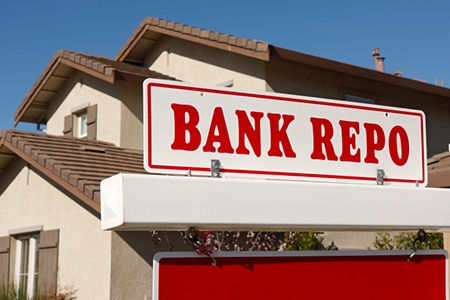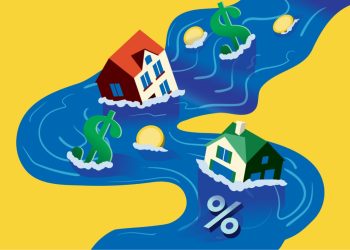 RealtyTrac® recently released its July 2015 U.S. Foreclosure Market Report™, which shows a total of 124,910 U.S. properties with foreclosure filings—default notices, scheduled auctions and bank repossessions—in July, up 7 percent from the previous month and up 14 percent from a year ago. July was the fifth consecutive month with a year-over-year increase in overall foreclosure activity following 53 consecutive months of decreases.
RealtyTrac® recently released its July 2015 U.S. Foreclosure Market Report™, which shows a total of 124,910 U.S. properties with foreclosure filings—default notices, scheduled auctions and bank repossessions—in July, up 7 percent from the previous month and up 14 percent from a year ago. July was the fifth consecutive month with a year-over-year increase in overall foreclosure activity following 53 consecutive months of decreases.
“The increase in overall foreclosure activity over the last five months has been driven primarily by rapidly rising bank repossessions, which in July reached the highest level since January 2013,” says Daren Blomquist, vice president at RealtyTrac. “Meanwhile foreclosure starts in July were at the lowest level since November 2005 — a nearly 10-year low that demonstrates the recent rise in bank repossessions represents banks flushing out old distress rather than new distress being pushed into the pipeline.
“This clearing of old distress is evident in the fact that properties foreclosed in the second quarter had been in the foreclosure process an average of 629 days, the longest in any quarter since we began tracking in the first quarter of 2007,” Blomquist continued. “It’s also evident that the recent surge in REOs is in fact clearing out more of the bad bubble-era loans from the so-called shadow inventory. RealtyTrac data now shows 61 percent of loans still in the foreclosure process were originated during the housing bubble years of 2004 to 2008, down from 68 percent last year and 75 percent two years ago.”
Bank repossessions at 30-month high, increase annually in 44 states
There were a total of 46,957 properties repossessed by lenders (REO) in July, up 29 percent from previous month and up 81 percent from a year ago to highest level since January 2013. Despite the recent increases, REOs in July were still less than half their peak of 102,134 in September 2010, but more than twice their pre-crisis average of 23,119 a month in 2005 and 2006.
REOs increased from a year ago in 44 states in July, including Florida (up 78 percent), California (up 23 percent), Texas (up 187 percent), Georgia (up 87 percent), Michigan (up 129 percent), Ohio (up 69 percent), and New Jersey (up 344 percent).
Foreclosure starts below pre-crisis levels, down annually in 31 states
There were a total of 45,381 U.S. properties that started the foreclosure process for the first time in July, down 8 percent from the previous month and down 9 percent from a year ago to the lowest level since November 2005 — a nearly 10-year low. Foreclosure starts in July were less than one-fourth of their peak of 203,948 in April 2009 and below their pre-crisis average of 52,279 a month in 2005 and 2006.
Foreclosure starts decreased from a year ago in 31 states in July, including California (down 25 percent), New York (down 19 percent), Texas (down 40 percent), Illinois (down 18 percent), Georgia (down 24 percent), Ohio (down 22 percent), Michigan (down 37 percent), and Maryland (down 15 percent).
States with increasing foreclosure starts—bucking the national trend—included Massachusetts (up 130 percent), New Jersey (up 76 percent), Missouri (up 72 percent), Wisconsin (up 27 percent), and Florida (up 16 percent).
Scheduled foreclosure auctions down after two months of increases
A total of 48,124 U.S. properties were scheduled for a future foreclosure auction in July, down 1 percent from the previous month and down 7 percent from a year ago following two consecutive months of year-over-year increases. Scheduled foreclosure auctions in July were less than one-third of their peak of 158,105 in March 2010 but still above their pre-crisis average of 33,634 a month in 2005 and 2006.
Scheduled foreclosure auctions—which are foreclosure starts in some states where they are the first public notice of foreclosure—increased from a year ago in 25 states, including New York (up 157 percent), New Jersey (up 101 percent), Massachusetts (up 54 percent), Connecticut (up 45 percent), Nevada (up 23 percent), Virginia (up 21 percent), and Illinois (up 19 percent).
13 of 20 largest U.S. metros post annual increase in foreclosure activity
Among the nation’s 20 largest metropolitan statistical areas by population, 13 posted year-over-year increases in overall foreclosure activity, led by St. Louis (up 148 percent), Boston (up 78 percent), New York (up 59 percent), Detroit (up 42 percent) and Philadelphia (up 40 percent).
Major markets with annual decreases in foreclosure activity in July were Houston (down 33 percent), Phoenix (down 23 percent), Riverside-San Bernardino (down 12 percent), Los Angeles (down 11 percent), Minneapolis (down 8 percent), San Diego (down 5 percent), and Chicago (down 2 percent).
Miami posted the highest foreclosure rate in July among the 20 largest metro areas. One in every 339 Miami housing units had a foreclosure filing in July—more than three times the national average of one in every 1,057 housing units with a foreclosure filing.
With one in every 375 housing units with a foreclosure filing, Tampa posted the second highest foreclosure rate among the 20 largest metro areas in July, followed by Baltimore (one in every 495 housing units), Chicago (one in every 586 housing units), and Philadelphia (one in every 627 housing units).
Atlantic city posts highest metro foreclosure rate, eight Florida cities in top 10
With one in every 258 housing units with a foreclosure filing in July—more than four times the national average—Atlantic City, N.J. posted the highest foreclosure rate among metropolitan statistical areas with a population of 200,000 or more.
Eight Florida metros were in the top 10 for foreclosure rates in July: Jacksonville (one in every 310 housing units with a foreclosure filing), Miami (one in every 339 housing units), Lakeland-Winter Haven (one in every 349 housing units), Deltona-Daytona Beach-Ormond (one in every 358 housing units), Tampa (one in every 375 housing units), Port St. Lucie (one in every 410 housing units), Orlando (one in every 433 housing units), and Palm Bay-Melbourne-Titusville (one in every 437 housing units).
Florida, Maryland, New Jersey post highest state foreclosure rates
Florida foreclosure starts increased 16 percent from a year ago in July following 10 consecutive months of year-over-year decreases, helping the state maintain the nation’s top foreclosure rate for the fifth month in a row. One in every 408 Florida housing units had a foreclosure filing in July—more than 2.5 times then national average.
Maryland foreclosure activity increased 8 percent from a year ago in July—the fourth consecutive month with a year-over-year increase—and the state posted the nation’s second highest foreclosure rate for the second month in a row. One in every 513 Maryland housing units had a foreclosure filing during the month.
New Jersey foreclosure activity increased 129 percent from a year ago in July—the fifth consecutive month with a year-over-year increase—and the state posted the nation’s third highest foreclosure rate for the second month in a row. One in every 520 New Jersey housing units had a foreclosure filing during the month.
Nevada foreclosure activity increased 10 percent from a year ago, and the state posted the nation’s fourth highest foreclosure rate—one in every 587 housing units with a foreclosure filing. Illinois foreclosure activity increased 2 percent from a year ago, and the state posted the nation’s fifth highest state foreclosure rate—one in every 730 housing units with a foreclosure filing.
Other states with foreclosure rates among the top 10 nationwide were New Mexico at No. 6 (one in every 741 housing units with a foreclosure filing), Georgia at No. 7 (one in every 900 housing units), South Carolina at No. 8 (one in every 923 housing units), Ohio at No. 9 (one in every 932 housing units), and North Carolina at No. 10 (one in every 970 housing units).
For more information, click here.










